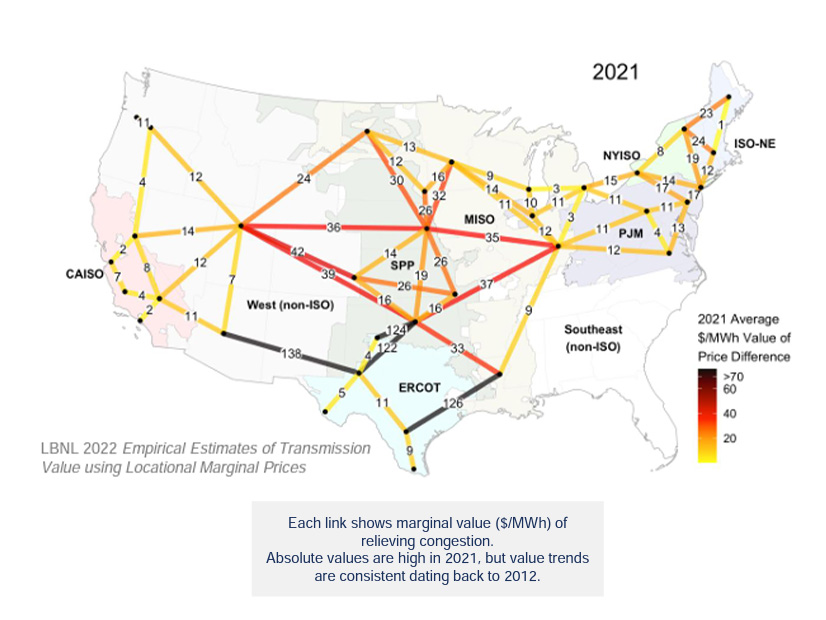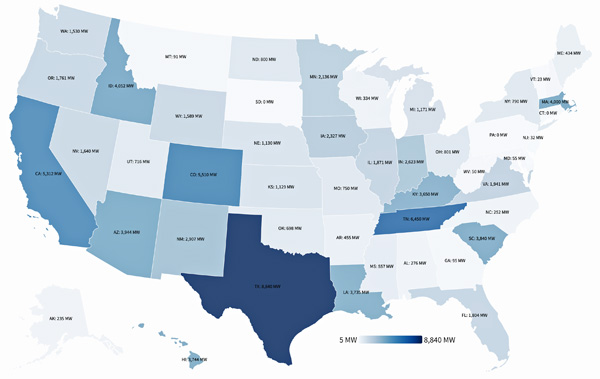State officials, RTOs and public interest groups warned the Department of Energy last week not to let transmission developers dominate the development of National Interest Electric Transmission Corridors (NIETCs), saying the program should not overrun states’ interests and existing regional transmission planning processes.
DOE received 112 comments in response to its May Notice of Intent/Request for Information on the proposed designations, which DOE says would “unlock new financing and regulatory tools” as well as federal siting and eminent domain authorities. (See DOE Rolls out New Process for Designating Key Transmission Corridors.)
Public officials, RTOs and trade and environmental groups were generally supportive, although many asked DOE to ensure it chooses only projects that improve resilience, enable connection of renewable generators or produce cost savings. There was wide agreement that DOE should prioritize interregional projects, and some commenters said the department should also encourage use of grid-enhancing technologies (GETs).
But some commenters challenged the legality of DOE’s proposed “applicant-driven, route-specific” approach. Individual landowners were almost universally opposed, criticizing the potential use of eminent domain by “greedy developers.”
Below, based on a review of the comments, is a summary of concerns and questions raised.
Eligibility Questions, States’ Role
The Infrastructure Investment and Jobs Act (IIJA) created the Transmission Facilitation Program, giving DOE $2.5 billion for public-private partnerships to co-develop transmission projects located within NIETCs. The Inflation Reduction Act (IRA) created the $2 billion Transmission Facility Financing program, allowing DOE to offer loan support to transmission facilities designated by the Energy Secretary as being in the national interest.
DOE said it expects that most proposed routes will be “associated with specific transmission projects under active development, meaning that a potential applicant has progressed beyond the preliminary concept and has begun actively routing the project and engaging in community and landowner outreach, land surveys or initiation of environmental compliance work.”
Although DOE said it expects most NIETC applicants to be transmission developers with a project under development, “no particular stage of development is required” for designation. (See related story, What are National Interest Electric Transmission Corridors and Why Do We Need Them?)
Public interest groups including the Natural Resources Defense Council, Earthjustice, the Southern Environmental Law Center and Environmental Defense Fund said DOE “must exercise independent judgment” in evaluating developers’ proposed corridors, warning that DOE’s proposed approach “risks conflating developers’ commercial interests with the national interest.”
“Although developers’ NIETC proposals may reveal where there is the greatest commercial interest in transmission development, there is no guarantee that developers will propose corridors that are truly in the ‘national interest,’” they wrote. “For example, they may hope that a NIETC designation will unlock financing that makes a transmission project easier to build or more profitable.”
State regulators submitted comments ranging from supportive to highly skeptical, with many expressing concern that DOE’s proposal would make private companies the only entities capable of applying to have NIETCs recognized. DOE said it may also allow tribal authorities, states, transmission-dependent utilities, local governments, generation developers and others to submit proposals.
The Mississippi and Louisiana public service commissions expressed strong opposition, saying the Federal Power Act grants the designation authority to the Secretary of Energy only, and contains “no language that authorizes the DOE to allow independent developers to make the NIETC designations based upon those developers’ own economic self-interests.”
They said the NOI could harm ratepayers. “Construction of transmission … can have enormous cost consequences on affected transmission facilities. Those consequences … must be remedied and financed by the entities causing those impacts.”
The Pennsylvania Public Utilities Commission also questioned allowing “private transmission developers to be the driving force” in designating NIETCs, adding that the NOI’s route-specific approach could create a presumption that transmission lines are the best solution to congestion and discourage investigation of other alternatives.
California’s Public Utilities Commission and its Energy Commission supported the plan overall, but urged DOE to open the application process to states, tribes and transmission operators. They also suggested creating an “applicant-driven ministerial certification process” for projects that address the purpose and needs of a given NIETC, which would encourage developers to participate in such projects while leaving state authorities and FERC in charge of the permitting process.
‘Clear and Prominent Role’
The New England States Committee on Electricity said DOE’s designation process “should provide a clear and prominent role for states,” allowing them to file applications for potential routes “where one or more potential transmission projects have clear state support” as well as providing input on others’ proposals. “Such an approach would recognize the primacy of the states’ role in siting transmission infrastructure and their authority over investments made to satisfy their own mandates and legal requirements,” NESCOE said.
The National Association of State Energy Officials (NASEO) said that, in light of the role of state energy offices in facilitating transmission upgrades and expansion, DOE should allow them to apply for NIETC designation as well. NASEO said state energy offices “have the tools, resources and knowledge to identify potential corridors that would benefit their states, regions and the nation.”
In a joint comment, the utility commissions of Michigan, New Jersey, North Carolina and Virginia pointed out that because “a NIETC designation has the potential to boost a project’s chance of being constructed considerably,” there is a danger that transmission developers could use the designation “strategically” to gain an advantage over projects “that may be better or more cost-effective.” The commissions also feared that the designation might help “shovel-ready” projects lose ground to less prepared developers.
The Edison Electric Institute said DOE’s process is “reactive” and would “unnecessarily limit DOE’s evaluation of corridors to only the areas, or indeed projects, submitted by applicants.”
Rather, it said DOE should, “proactively identify the geographic areas exhibiting the most significant or persistent need for immediate transmission development.”
The American Public Power Association said DOE should also allow transmission-dependent utilities to apply for NIETC designation and participate in joint ownership of projects, which it said could save ratepayers money and help win local support.
“The diversity gained by including public power in joint ownership arrangements can help with the acquisition of rights-of-way and permits, by having a broader and more diverse set of utilities advocating for projects at the state level. Engaging more rural communities and helping to bridge urban-rural division, as well as being more inclusive of rural communities, are additional public policy benefits of joint ownership arrangements that include public power,” APPA said.
Respect Existing Planning Processes
CAISO, PJM and the MISO Transmission Owners were among those insisting that any procedures the DOE settles on should complement existing transmission planning efforts.
WIRES, a trade association representing transmission providers, developers, customers and regional grid managers, cautioned DOE against allowing the NIETC designation process to “inject unhelpful uncertainty into regulated transmission planning processes.” It said ongoing planning initiatives like MISO’s long-range transmission planning shouldn’t be undermined by DOE “potentially elevating” inefficiently planned projects over those contemplated in FERC-approved planning processes.
“That situation could slow progress and erode stakeholder support for these plans and/or make it more difficult to move ahead with regionally planned portfolios that have been in the works for years,” WIRES said.
WIRES, state regulators and PJM said DOE should require projects be included in a regional transmission plan before they can receive a NIETC designation.
“The NIETC process should not be used to circumvent [RTOs’] transmission planning processes. If a project is proposed as part of the RTO planning process and does not meet RTO planning or benefit criteria, then [its] proponent should not have recourse to the NIETC process to push that project into construction,” regulators from Michigan, New Jersey, North Carolina and Virginia said in a joint comment. “Both are federal processes — one subject to a FERC-accepted tariff, the other this application process. Having two conflicting federally approved processes would deter, rather than promote, responsible transmission planning.”
APPA agreed. “Failure of a proposed project to participate in a regional, interregional or even local planning process should weigh heavily against NIETC designation, particularly since a NIETC designation (and the prospect of FERC backstop approval) might otherwise encourage transmission developers to circumvent regional transmission planning and/or interregional coordination,” APPA said.
PJM said that without an “orderly, sequential NIETC process” that recognizes the authority of RTOs and ISOs, “DOE could find itself having to referee among developers/applicants who are seeking to end-run the detailed RTO/ISO analyses and competitive planning processes … Absent such a clearly-defined and sequential process, the roles of an RTO/ISO as a Planning Authority could be blurred with DOE potentially granting a NIETC designation that is at odds with the reliability, market efficiency and state public policy analyses undertaken by the RTO/ISO in choosing among competing projects.”
Invenergy said DOE should solicit interregional merchant transmission projects, “which have the potential to solve critical interregional needs while largely avoiding contentious discussions on cost allocation, but which face unique barriers and hurdles.”
“DOE must ensure that the process is equally accessible to transmission developers and transmission projects regardless of their business model and inclusion (or not) in a FERC-approved regional transmission planning process. Since many of the FERC-approved regional transmission planning processes exclude from consideration merchant transmission projects, as well as any other transmission projects not seeking cost allocation, inclusion in such a plan must not be a criteria in the NIETC process. … FERC-approved regional planning processes tend to be narrowly focused, considering only benefits that accrue to that particular region and specific needs identified by the region.”
ERCOT meanwhile made clear it wants no part of NIETC, saying DOE should ensure that “a proposed NIETC does not include any portion of the ERCOT region.”
Metrics and Priorities
EEI criticized the NOI/RFI for lacking information on how DOE will compare and prioritize NIETC applications. “Section 216 of the Federal Power Act does not limit the number of national interest corridors that DOE may designate, but reason demands that DOE cannot designate every submitted application (or even many applications) as a NIETC,” EEI said. “… An explanation with respect to how DOE will evaluate the magnitude and effects of the transmission needs in proposed corridors would ensure that DOE designates the corridors of greatest need. This would further ensure prudent management of the financing tools created by the Infrastructure Investment and Jobs Act and Inflation Reduction Act.”
Idaho Power said DOE should use available transmission capacity as an indicator of areas with constraints. “The amount of transmission service requests that entities receive for a given corridor and the cost of required transmission upgrades identified in transmission service request studies is also a potential metric,” the company said. LMP data from the Western Energy Imbalance Market could be used to identify areas with large reoccurring price spreads in the Western Interconnection, it added.
The New York Transmission Owners said DOE’s pending Transmission Needs Study should incorporate existing transmission planning processes rather than relying solely on National Renewable Energy Laboratory modeling for projecting future transmission expansion. DOE issued a draft Needs Study in February and expects to issue the final study later this summer.
“It is important that the study’s findings are reconciled with existing transmission planning, including existing planned project solutions, in DOE’s consideration of NIETC designations,” the TOs said.
NRDC and the other public interest groups said DOE should favor proposals that “provide the greatest and most immediate benefits in terms of increasing interregional transfer capacity and diversification of regional resources to speed the development of wind, solar and storage resources …” and “highly prioritize GHG reductions.”
The groups said interregional transmission has shown strong benefit-to-cost ratios and cited calculations by MIT researchers who found that “interstate coordination and transmission expansion [including across regions and interconnections] reduces the system cost of electricity in a 100%-renewable U.S. power system by 46% compared with a state-by-state approach, from $135/MWh to $73/MWh.”
“Because [interregional] projects provide great benefits but face great obstacles, they provide the best opportunity for DOE to maximize the positive impacts from NIETC designations,” the groups added.
Broad or Specific Designations?
The Rail Electrification Council and NextGen Highways, which suggested NIETC designations for existing railroad or highway rights of way, praised DOE for focusing on narrower areas and specific projects than in the first NIETC effort, “an ambitious approach in 2006 that set itself up for rejection by the courts.”
In 2011, the Ninth Circuit Court of Appeals vacated the first National Electric Transmission Congestion Study and its designation of the Mid-Atlantic Area national corridor and the Southwest Area corridor.
“The regional breadth of prior designations … made adequate identification and consultation with stakeholders extraordinarily difficult because of the volume and variety of landowner, environmental, economic and other issues involved,” the groups said.
However, Power From the Prairie, a proposed, 4,000-MW interregional HVDC line from southern Wyoming to northwestern Iowa, asked DOE to define NIETC corridors “broadly,” not tying them to any established routes. It also said DOE could consider establishing a separate “promising NIETC candidate project in-waiting” category for lines in the early stages of development.
NRDC and its allies supported DOE making NIETC designations not associated with a project under development. “DOE is well-situated to identify corridors that are in the national interest but where private development alone may be too challenging,” they said.
EEI said DOE should reconcile an apparent conflict in the NOI/RFI between the department’s assurance that it “does not intend to identify preference for specific projects within the corridors” and its assumption that proposed NIETCs will likely be “route-specific.”
PJM said if DOE opens NIETC applications to generation and merchant transmission developers it should limit it to those with executed interconnection agreements.
But Con Edison said DOE should not reject projects in the early stages of development that lack details on routing and environmental impact. “Projects in the conceptual or preliminary stages of development may have significant value and stakeholder support to address emerging clean energy needs, and therefore should be accommodated and not overlooked or delayed through the DOE process due to their nascent status,” the company said.
Balancing Climate and Conservation
The Arizona Game and Fish Department said while DOE is on the right track to include state, tribal and local authorities in NIETCs planning, it should also explicitly state that applicants consult with state wildlife agencies and other natural resource agencies to select routes that minimize habitat damage.
“State wildlife agencies can provide specific recommendations and information from subject matter experts on sensitive resources, species occurrence and distributions, areas of concern, wildlife connectivity, and more, as well as advise on potential conservation measures to avoid, minimize or offset potential impacts,” the Arizona agency said.
Conservation organization the Land Trust Alliance urged the DOE to write in explicit protections for conserved lands; incentivize proposals that utilize existing rights of way and minimize the land use footprint of transmission corridors; and only accept route-specific applications for consideration to avoid “orphaned NIETCs that are never built out due to conservation needs being identified too late in the process.”
“We must not undermine our nation’s investments in and future needs for conservation by siting energy transmission infrastructure in such sensitive environmental areas as conserved lands or lands with high conservation or agricultural values. For our nation to achieve its climate goals, there must be a balance of planning for clean energy through smart siting that recognizes conservation goals.”
A group of cities and communities across PJM and MISO called on DOE to develop a replicable and transparent designation process with community workshops and roundtables. They also asked DOE to require applicants to submit community benefits plans and address equitable siting issues.
“The process should seek to balance the need for timely transmission and infrastructure development with community priorities,” the PJM and MISO communities said.
Legal Questions
Several commenters raised legal questions over DOE’s proposed approach.
The sponsors of the Southeastern Regional Transmission Planning Process (SERTP) — including Southern Company, Duke Energy and Louisville Gas and Electric Co./Kentucky Utilities Co. — said the applicant-driven, route-specific NIETC designation is “inconsistent” with the Federal Power Act and could override state resource plans or regional transmission planning.
EEI challenged DOE’s contention that the NIETC process is only guidance, saying the department must adhere to the notice-and-comment rulemaking requirements of the Administrative Procedure Act.
“DOE has taken the position that the designation of NIETCs constitute informal adjudications under the APA, not informal rulemakings. While that may be a defensible interpretation as to any given designation of a specific NIETC, that is not what DOE intends to accomplish in the planned ‘guidance’ that the NOI lays the groundwork for,” EEI said. “Rather, the planned ‘guidance’ would establish a prospective, broadly applicable framework for the designation of all route-specific NIETCs. DOE must do so through a rulemaking.”
Farm bureaus from multiple states — aware that their members may have lands seized through eminent domain — argued that the DOE doesn’t have the authority under the FPA to prescribe applicant-driven, route-specific framework for corridors, which would “put the cart before the horse,” they said. Rather, they said the DOE should “solicit input regarding specific geographic areas that should be designated as NIETCs, but not specific projects needed to alleviate congestion or constraints in those areas.”
DOE cannot solicit projects that are already under development and draw a corridor around them, the farm bureaus said. Instead, they said the department must defer to states and regional planning authorities.
Some commenters questioned DOE’s proposal to limit applicants’ “Affected Environmental Resources and Impacts Summary” to 20 single-spaced pages, not including maps. The filing is required to detail engagements with “Communities of Interest,” the status of regulatory approvals and whether the project has been included in any local or regional transmission plans. DOE also asks applicants to explain if they are using transmission technologies such as advanced conductors that allow more capacity in smaller corridors.
The Arizona Game and Fish Department said the limit should be removed.
Next Steps
DOE’s NOI/RFI doesn’t say how soon it will finalize its guidance on the NIETC program after reviewing comments. It has said it expects to post the final Needs Report in late summer 2023.



